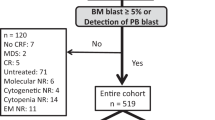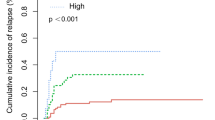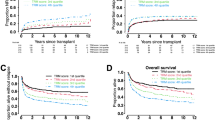Abstract
Outcomes after allogeneic stem-cell transplantation (AHSCT) are influenced by both disease- and patient-related factors. Here, we developed a novel prognostic model, hematopoietic cell transplant-composite risk (HCT-CR), by combining the refined disease risk index (DRI-R) and hematopoietic stem-cell transplant comorbidity/age index (HCT-CI/Age) to predict post-transplant survival for patients with acute myeloid leukemia (AML) and myelodysplastic syndrome (MDS). The analysis included 942 AML/MDS patients treated with AHSCT. Patients were stratified into 4 HCT-CR risk groups: Low-risk—patients with low/intermediate DRI-R and HCT-CI/Age ≤3 (N = 272); Intermediate-risk—patients with low/intermediate DRI-R and HCT-CI/Age >3 (N = 168); High-risk—patients with high/very high DRI-R and HCT-CI/Age ≤3 (N = 284); and Very high-risk—patients with high/very high DRI-R and HCT-CI/Age >3 (N = 184). Compared with the low-risk group, intermediate, high, and very high-risk groups had a significantly increased risk of death [adjusted HR of 1.37 (P < 0.04), 2.08 (P < 0.001), and 2.92 (P < 0.001), respectively]. The concordance test showed that the HCT-CR model provided better discriminative capacity for OS prediction compared with all prior models independently, including cytogenetic risk group, DRI-R, and HCT-CI/Age model (C-indices: 0.62, 0.55, 0.60, and 0.54, respectively) (P < 0.001). In conclusion, combining disease- and patient-related factors provides better survival stratification for patients with AML/MDS receiving AHSCT.
This is a preview of subscription content, access via your institution
Access options
Subscribe to this journal
Receive 12 print issues and online access
$259.00 per year
only $21.58 per issue
Buy this article
- Purchase on Springer Link
- Instant access to full article PDF
Prices may be subject to local taxes which are calculated during checkout


Similar content being viewed by others
References
Koreth J, Schlenk R, Kopecky KJ, Honda S, Sierra J, Djulbegovic BJ, et al. Allogeneic stem cell transplantation for acute myeloid leukemia in first complete remission: systematic review and meta-analysis of prospective clinical trials. JAMA. 2009;301:2349–61.
Weisdorf DJ, Millard HR, Horowitz MM, Hyare PS, Champlin R, Ho V, et al. Allogeneic transplantation for advanced acute myeloid leukemia: the value of complete remission. Cancer. 2017;123:2025–34.
Di Stasi A, Milton DR, Poon LM, Hamdi A, Rondon G, Chen J, et al. Similar transplantation outcomes for acute myeloid leukemia and myelodysplastic syndrome patients with haploidentical versus 10/10 human leukocyte antigen-matched unrelated and related donors. Biol Blood Marrow Transplant. 2014;20:1975–81.
Ciurea SO, Zhang MJ, Bacigalupo AA, Bashey A, Appelbaum FR, Aljitawi OS, et al. Haploidentical transplant with posttransplant cyclophosphamide vs matched unrelated donor transplant for acute myeloid leukemia. Blood. 2015;126:1033–40.
Ballen KK, Lazarus H. Cord blood transplant for acute myeloid leukaemia. Br J Haematol. 2016;173:25–36.
Craddock CF. Full-intensity and reduced-intensity allogeneic stem cell transplantation in AML. Bone Marrow Transplant. 2008;41:415–23.
Todisco E, Ciceri F, Oldani E, Boschini C, Mico C, Vanlint MT, et al. The CIBMTR score predicts survival of AML patients undergoing allogeneic transplantation with active disease after a myeloablative or reduced intensity conditioning: a retrospective analysis of the Gruppo Italiano Trapianto Di Midollo Osseo. Leukemia. 2013;27:2086–91.
Sorror ML, Storb RF, Sandmaier BM, Maziarz RT, Pulsipher MA, Maris MB, et al. Comorbidity-age index: a clinical measure of biologic age before allogeneic hematopoietic cell transplantation. J Clin Oncol. 2014;32:3249–56.
Sorror ML, Maris MB, Storb R, Baron F, Sandmaier BM, Maloney DG, et al. Hematopoietic cell transplantation (HCT)-specific comorbidity index: a new tool for risk assessment before allogeneic HCT. Blood. 2005;106:2912–9.
Gratwohl A, Stern M, Brand R, Apperley J, Baldomero H, de Witte T, et al. Risk score for outcome after allogeneic hematopoietic stem cell transplantation: a retrospective analysis. Cancer. 2009;115:4715–26.
Raimondi R, Tosetto A, Oneto R, Cavazzina R, Rodeghiero F, Bacigalupo A, et al. Validation of the Hematopoietic Cell Transplantation-Specific Comorbidity Index: a prospective, multicenter GITMO study. Blood. 2012;120:1327–33.
Versluis J, Labopin M, Niederwieser D, Socie G, Schlenk RF, Milpied N, et al. Prediction of non-relapse mortality in recipients of reduced intensity conditioning allogeneic stem cell transplantation with AML in first complete remission. Leukemia. 2015;29:51–7.
Nakaya A, Mori T, Tanaka M, Tomita N, Nakaseko C, Yano S, et al. Does the hematopoietic cell transplantation specific comorbidity index (HCT-CI) predict transplantation outcomes? A prospective multicenter validation study of the Kanto Study Group for Cell Therapy. Biol Blood Marrow Transplant. 2014;20:1553–9.
Barba P, Martino R, Perez-Simon JA, Fernandez-Aviles F, Castillo N, Pinana JL, et al. Combination of the Hematopoietic Cell Transplantation Comorbidity Index and the European Group for Blood and Marrow Transplantation score allows a better stratification of high-risk patients undergoing reduced-toxicity allogeneic hematopoietic cell transplantation. Biol Blood Marrow Transplant. 2014;20:66–72.
Armand P, Gibson CJ, Cutler C, Ho VT, Koreth J, Alyea EP, et al. A disease risk index for patients undergoing allogeneic stem cell transplantation. Blood. 2012;120:905–13.
Armand P, Kim HT, Logan BR, Wang Z, Alyea EP, Kalaycio ME, et al. Validation and refinement of the Disease Risk Index for allogeneic stem cell transplantation. Blood. 2014;123:3664–71.
Weisdorf D, Spellman S, Haagenson M, Horowitz M, Lee S, Anasetti C, et al. Classification of HLA-matching for retrospective analysis of unrelated donor transplantation: revised definitions to predict survival. Biol Blood Marrow Transplant. 2008;14:748–58.
Armand P, Kim HT, Zhang MJ, Perez WS, Dal Cin PS, Klumpp TR, et al. Classifying cytogenetics in patients with acute myelogenous leukemia in complete remission undergoing allogeneic transplantation: a Center for International Blood and Marrow Transplant Research study. Biol Blood Marrow Transplant. 2012;18:280–8.
Armand P, Deeg HJ, Kim HT, Lee H, Armistead P, de Lima M, et al. Multicenter validation study of a transplantation-specific cytogenetics grouping scheme for patients with myelodysplastic syndromes. Bone Marrow Transplant. 2010;45:877–85.
Gray RJ. A class of K-sample tests for comparing the cumulative incidence of a competing risk. Ann Stat. 1988;16:1141–54.
Efron B, Tibshirani RJ. An introduction to the bootstrap. CRC Press, USA; 1994.
Kohavi R, editor. A study of cross-validation and bootstrap for accuracy estimation and model selection. IJCAI, Montreal, Canada; 1995.
Estey E, de Lima M, Tibes R, Pierce S, Kantarjian H, Champlin R, et al. Prospective feasibility analysis of reduced-intensity conditioning (RIC) regimens for hematopoietic stem cell transplantation (HSCT) in elderly patients with acute myeloid leukemia (AML) and high-risk myelodysplastic syndrome (MDS). Blood. 2007;109:1395–400.
Muffly L, Pasquini MC, Martens M, Brazauskas R, Zhu X, Adekola K, et al. Increasing use of allogeneic hematopoietic cell transplantation in patients aged 70 years and older in the United States. Blood. 2017;130:1156–64.
Slack JL, Dueck AC, Fauble VD, Sproat LO, Reeder CB, Noel P, et al. Reduced toxicity conditioning and allogeneic stem cell transplantation in adults using fludarabine, carmustine, melphalan, and antithymocyte globulin: outcomes depend on disease risk index but not age, comorbidity score, donor type, or human leukocyte antigen mismatch. Biol Blood Marrow Transplant. 2013;19:1167–74.
Thanarajasingam G, Kim HT, Cutler C, Ho VT, Koreth J, Alyea EP, et al. Outcome and prognostic factors for patients who relapse after allogeneic hematopoietic stem cell transplantation. Biol Blood Marrow Transplant. 2013;19:1713–8.
Bachegowda LS, Saliba RM, Ramlal R, Kongtim P, Chen J, Rondon G, et al. Predictive model for survival in patients with AML/MDS receiving haploidentical stem cell transplantation. Blood. 2017;129:3031–3.
Author contributions
PK contributed with study design, data analysis, interpretation, and wrote the manuscript; SP contributed with interpretation of the study results, reviewed and approved the manuscript; DRM contributed with data analysis, interpretation of the results, wrote, reviewed and approved the manuscript; JMRP contributed with manuscript writing, reviewed and approved the manuscript; GR, JC, and AC contributed with data collection, reviewed and approved the manuscript; GA, AA, BSA, JSI, CMH, QB, IK, PK, BO, UP, and RC contributed with treatment of patients, reviewed and approved the manuscript; SOC contributed with study design, data collection and interpretation of results, and manuscript writing.
Author information
Authors and Affiliations
Corresponding author
Ethics declarations
Conflict of interest
The authors declare that they have no conflict of interest.
Electronic supplementary material
Rights and permissions
About this article
Cite this article
Kongtim, P., Parmar, S., Milton, D.R. et al. Impact of a novel prognostic model, hematopoietic cell transplant-composite risk (HCT-CR), on allogeneic transplant outcomes in patients with acute myeloid leukemia and myelodysplastic syndrome. Bone Marrow Transplant 54, 839–848 (2019). https://doi.org/10.1038/s41409-018-0344-9
Received:
Revised:
Accepted:
Published:
Issue Date:
DOI: https://doi.org/10.1038/s41409-018-0344-9
This article is cited by
-
Predicting non-relapse mortality following allogeneic hematopoietic cell transplantation during first remission of acute myeloid leukemia
Bone Marrow Transplantation (2021)
-
Does one model fit all? Predicting non-relapse mortality after allogeneic hematopoietic cell transplantation
Bone Marrow Transplantation (2021)
-
A novel Iowa–Mayo validated composite risk assessment tool for allogeneic stem cell transplantation survival outcome prediction
Blood Cancer Journal (2021)
-
The evolving concept of indications for allogeneic hematopoietic cell transplantation during first complete remission of acute myeloid leukemia
Bone Marrow Transplantation (2021)
-
Outcomes of pediatric patients with therapy-related myeloid neoplasms
Bone Marrow Transplantation (2021)



